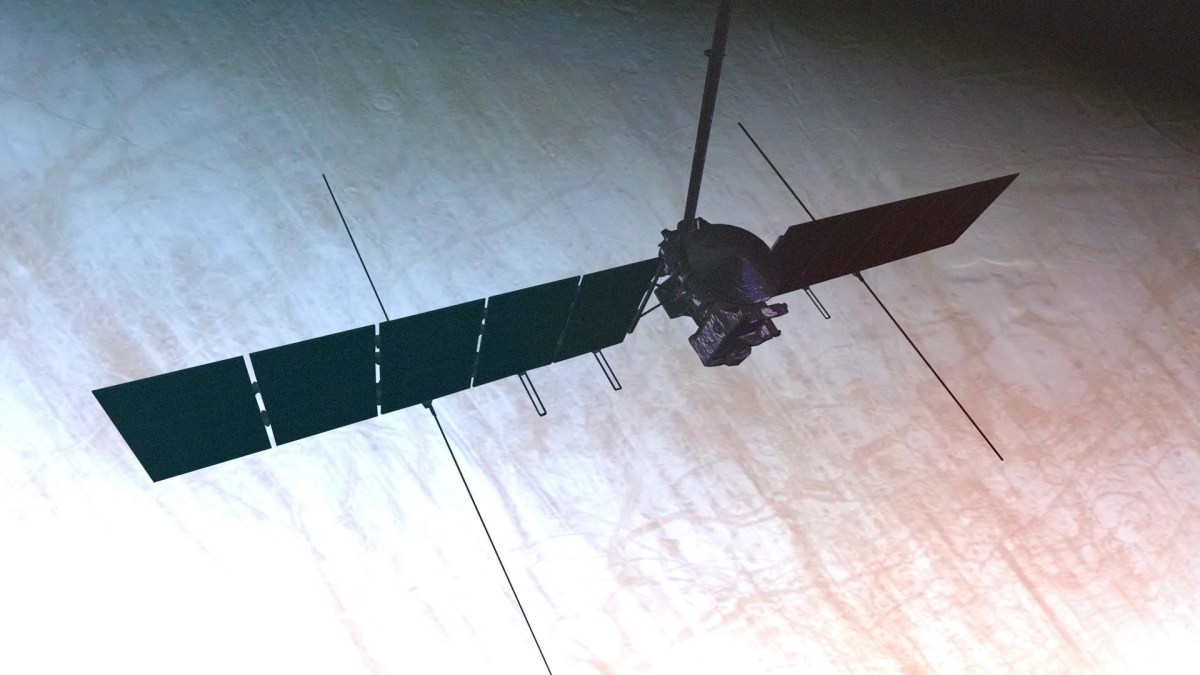MILAN — NASA and SpaceX are ready to launch a multibillion-dollar mission to a moon of Jupiter to see if that world could support life.
At an Oct. 13 briefing, officials said they were ready for a launch of NASA’s Europa Clipper spacecraft on a SpaceX Falcon Heavy at 12:06 p.m. Eastern Oct. 14 from the Kennedy Space Center in Florida.
The launch was originally scheduled for Oct. 10, but the passage of Hurricane Milton across Florida delayed the launch. The storm, though, did no damage to Launch Complex 39A at KSC or other facilities needed to support the launch.
“The Europa Clipper spacecraft is ready for its ride into space,” said Jordan Evans, project manager for the mission at the Jet Propulsion Laboratory, at the briefing. Final checks of the spacecraft turned up no issues with it, he noted. “At this point, we are monitoring a very well-behaved spacecraft.”
One issue the mission did have to address was an anomaly during the deorbit burn of a Falcon 9 upper stage after the Sept. 28 launch of NASA’s Crew-9 mission to the International Space Station. That anomaly caused the upper stage to fall outside of the planned deorbit zone in the South Pacific Ocean. It grounded the vehicle, with the exception of the launch of the Hera asteroid mission Oct. 7, until the Federal Aviation Administration cleared the vehicle for launches in general Oct. 11.
At the briefing, Julianna Scheiman, director of NASA science missions at SpaceX, said on the Crew-9 flight the upper stage’s single Merlin engine “continued to produce thrust for about 500 milliseconds after the shutdown was commanded.” A backup command was sent to close valves to shut down the engine.
“The SpaceX and NASA teams pored over all of this data together and have cleared this specific issue for Europa Clipper,” she said, as the Falcon Heavy’s upper stage is similar to the Falcon 9 upper stage. She did not elaborate on what caused the engine to run half a second longer than expected.
Tim Dunn, senior launch director in NASA’s Launch Services Program, said NASA convened its own independent review board to examine the data. “We assessed and cleared Europa Clipper of this anomaly,” he said.
NASA at one point was considering an Oct. 13 launch, but pushed it back a day because launch teams were “continuing to do checkouts to ensure flight readiness,” the agency stated Oct. 11. At the briefing, Scheiman said an internal “paranoia scrub” at SpaceX raised a potential quality control issue with tubing on the rocket.
That issue, which she said was not linked to anything seen on the Falcon 9 launch of Hera, prompted examination of work orders and other information to confirm that the issue did not affect the tubing on this Falcon Heavy.
Dunn said SpaceX raised the issue Oct. 10, prompting reviews that extended into Oct. 12. “SpaceX was very accommodating with everything that we, NASA, asked to assure mission success for Europa Clipper,” he said. “We’re in very good shape.”
“We fly when we’re ready,” Scheiman said, “and we’re ready and looking forward to tomorrow.”
The launch will send the 5,700-kilogram Europa Clipper spacecraft on a trajectory that will include a flyby of Mars in March 2025 and Earth in December 2026 before arriving at Jupiter in April 2030.
Spacecraft separation from the Falcon Heavy upper stage will take place just over an hour after liftoff. The first signals from the spacecraft should be received between 5 and 19 minutes after separation. A couple hours later, the spacecraft will begin the process of deploying its large solar arrays, although Evans said on the call it will take “a little while” after that deployment sequence to confirm the panels are working as intended.
Once entering orbit around Jupiter, the spacecraft will make dozens of close approaches of Europa, an icy moon thought to have a subsurface ocean that could be habitable. “Europa is a fascinating destination,” said NASA Associate Administrator Jim Free. “Clipper is the first NASA spacecraft dedicated to studying an ocean world beyond Earth.”
The potential to determine if Europa is habitable made the mission a top priority among planetary scientists even as its overall cost, including operations through a prime mission at Jupiter extending to 2034, grew to $5.2 billion.
The demands of the mission pushed the performance of the spacecraft and the launch vehicle. None of the three booster cores of this Falcon Heavy will be recovered to maximize vehicle performance to send Europa Clipper on its way to Jupiter.
“I can’t think of a better mission to sacrifice boosters for,” Scheiman said. “We might have the opportunity to discover life in our own solar system.”
